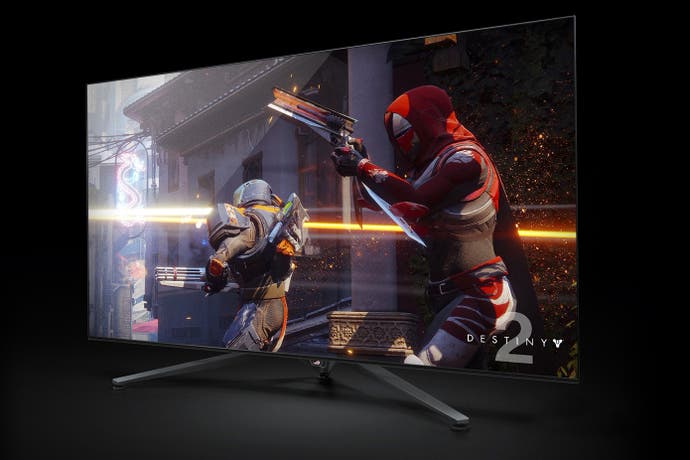Nvidia unveils Big Format Gaming Displays: 65-inch 120Hz G-Sync 4K monitors
BFGDs are premium PC displays for the living room.
Nvidia has revealed a new range of ultra high-end, 65-inch gaming monitors designed for the living room, dubbed BFGDs - or Big Format Game Displays.
Working initially in combination with Asus, Acer and HP, Nvidia's technology features a 4K panel operating at 120Hz with G-Sync technology, paired with HDR functionality with 1000 nits peak brightness and a DCI-P3 colour gamut. The firm is also promising low latency, with response more in line with cutting-edge PC monitors as opposed to the more laggy flat-panels typically found in more traditional 4K flat panel televisions.
Further sweetening the deal is that Nvidia is integrating its Shield Android TV streamer into these monitors, meaning access to GeForce Now cloud gaming, all the major streaming video platforms (including Netflix and Amazon). With the utilisation of G-Sync, Nvidia promises that media - not just games - will automatically refresh at the source frequency, meaning that movies will switch the panel to 24Hz, for example (although many screens can do this already).
Nvidia is promising compatibility with standard games consoles (whether they support HDR or not), effectively confirming that HDMI ports are included on the displays, in combination with whatever solution Nvidia chooses to power through 4K gaming content at 120Hz. By extension, this support for standard HD and UHD sources means that set-top boxes for standard HD and UHD TV content should work just fine.
With specs pushed to the max in all areas - not least in terms of screen-sizes - we should expect premium price-points for the BFGDs, and it's to be expected bearing in mind that the FreeSync-like HDMI 2.1 variable refresh technology should start to appear in consumer-level 4K displays over the next year. G-Sync has always been positioned as the premium option in the PC display space, and Nvidia is clearly looking to do the same with living room screens. From our perspective, while G-Sync may command a gold standard in terms of its feature set and performance, the proliferation of FreeSync screens and the upcoming arrival of HDMI 2.1 variable refresh for consumer 4K TVs presents a strong argument for the green team to embrace both standards.
One aspect of the announcement that did surprise us is that Nvidia has partnered with traditional PC monitor manufacturers for this new initiative, as opposed to consumer display giants such as Samsung and LG. Nvidia clearly takes pride in the quality of its validated panels, but we're going to be fascinated to see how these screens compare to the likes of OLED technology, which has proven to be a superb fit for gaming, with prices on screens like the excellent LG OLED B7 gradually coming down to more realistic levels.
And on the flip-side, as exciting as BFGDs are, we still believe that there's a yawning chasm in the monitor market for 32-inch to 42-inch desktop monitors with exactly the feature-set being rolled out for these living room monsters. Our fingers are crossed that more reasonably sized offerings (MRSGDs?) will appear in the fullness of time.


